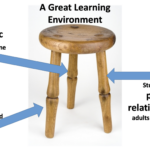You may think of the first weeks of school as a time to focus on classroom management, and it is. But in fact, all year long, we should consider classroom management an active part of our daily teaching. How do
A great learning environment is like a three-legged stool. Ruth Charney first introduced this concept to me years ago. It’s an important idea to keep in mind all year long, but it’s crucial during the first weeks of school.
The
Walk through most schools, and you’ll see messages like the ones above, posted in classrooms and in hallways. We often encourage kids, as they’re about to work to “try your best” or “put in max effort.” One year in
A few years ago my wife gave me three months of coaching for my birthday. I’d been running 5K road races and was trying some half-marathons. She thought I could use some professional help! We connected online, and I sent
This is probably a bit of a misleading title since there are plenty of overlaps between teaching SEL and character ed. If we put these two terms into a Venn diagram, we’d find plenty of overlaps. In my mind, there’s
What did the mathematical acorn say when he grew up?
“Ge-om-e-try!” (“Gee, I’m a tree!”)
Ah—dad jokes. Silly plays on words. Puns. Cornball humor. Eye-rollers. Groaners.
Ted Lasso is packed with goofy humor. Have you noticed how this keeps your
My wife and I loved watching Ted Lasso. In fact, when our daughter came home from college for the holidays, we got her into it and watched both seasons again! One of the most powerful and uplifting scenes comes in
Even if you haven’t binge-watched Ted Lasso like I have (twice!), you’ve probably heard of it. In this blog post, we’ll explore one of Ted Lasso’s classic lines: Be a Goldfish and consider how it might help us when we’ve
A Brief History of Behaviorism, Part 5
If you could travel back in time about 60 years and walk through a typical school, you might be surprised to find something missing. You wouldn’t see behavior charts or “star student” award
A Brief History of Behaviorism, Part 4
If you could travel back in time about 60 years and walk through a typical school, you might be surprised to find something missing. You wouldn’t see behavior charts or “star student” award
A Brief History of Behaviorism, Part 3
If you could travel back in time about 60 years and walk through a typical school, you might be surprised to find something missing. You wouldn’t see behavior charts or “star student” award
A Brief History of Behaviorism, Part 2
If you could travel back in time about 60 years and walk through a typical school, you might be surprised to find something missing. You wouldn’t see behavior charts or “star student” award
Do your students seem young this year? You’re not alone. In every single school I’m working in this year—with no exceptions—teachers are saying the same kinds of things.
This shouldn’t be surprising. Students always seem a bit young in the
It is now widely recognized that social-emotional learning (SEL) should be an integral part of teaching and learning in schools. Yet it sometimes feels so overwhelming. SEL is just so…BIG. How do you know where to start?
Some districts purchase
Are incentive systems used in your school? Do kids get handed tickets or fake money (to be spent at the school store) for walking quietly in hallways? Are gem and marble jars used to motivate kids to raise their hands
Do you care about equity in your school? Do you believe that all children should have a fair chance at school success?
It’s common for grade levels or departments to create long lists of supplies that students are expected to
If you teach reading and/or writing, there’s a good chance that when introducing a new concept or skill, you begin your lesson by saying some variation of, “Good readers….”
“Good readers pay attention to context clues.”
“Good writers add
Good teaching is good teaching is good teaching, whether you're helping fourth graders learn to multiply or teaching a wide receiver a new play.












